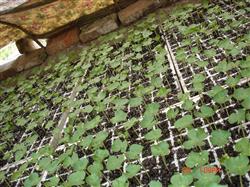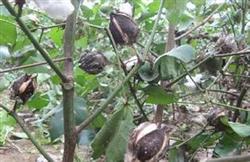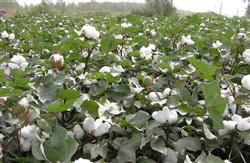Cotton topdressing should be in advance.

Cotton has entered a period of vigorous growth from the early flowering stage, which requires a lot of fertilizer, nitrogen absorption and high intensity. the amount of nitrogen absorbed from this time accounts for 60% of the total nitrogen absorption during the whole growth period, and the phosphorus and potassium needed in this period also account for more than half of the total. The fertilization principle of high-yield cotton is to do a good job of topdressing management on the basis of base fertilizer. In recent years, the development trend of cotton high-yield cultivation management is to achieve high yield by increasing sandalwood cotton density under the condition of systematic chemical control. In addition, in order to ensure the continuous increase of the total output of cotton and food crops in the Yangtze River Basin and North China, there has been a trend of shortening the cotton growth period and vigorously developing summer sowing cotton in recent years. For these two new developments, there should be corresponding new countermeasures in cotton topdressing management. In the past, cotton sowing in spring was mainly planted, emphasizing the backward movement of topdressing (mainly referring to nitrogen fertilizer), and the goal was to strive for the "three peaches", that is, the high-yield plant type which required the cotton plant to bring peach in, cover the waist and cover the top of autumn peach. therefore, the principle of re-applying boll fertilizer and topdressing fertilizer was put forward. However, the situation is different now, and we should move forward appropriately in the period of topdressing. Under the condition of chemical control of thalidomide system, early application of bud fertilizer has a good effect on the high yield of spring cotton, such as enhancing root activity as early as possible. Therefore, the application of chemical control technology provides a guarantee for adjusting the time of topdressing. Topdressing before closing ridges in cotton fields can reduce labor and mechanical damage of cotton plants, especially summer sowing cotton or short-season cotton must emphasize early topdressing at the bud stage to ensure the early development of cotton seedlings. avoid the threat of late maturity. In short, under the premise of systematic control, cotton fertilization is based on the principle of base fertilizer and appropriate early application of topdressing. In recent years, the high-yield sample field of cotton has shown that under the condition of the use of mepivacaine, early topdressing is beneficial to root growth and prevention of root premature senescence. In general, it is feasible to advance the topdressing stage of summer sowing cotton to bud stage (4-5 leaves) combined with topdressing in hoeing. Topdressing is also feasible at the early flowering stage (1 or 2 young bolls have been hung). The topdressing at bud stage or early flowering stage is mainly to add appropriate amount of nitrogen fertilizer (such as 10kg / mu urea). In the cotton field with potassium deficiency, low available potassium content (such as sandy light loam) or without potassium and organic fertilizer in the base fertilizer, 5kg potassium chloride should be added. At this time, potassium topdressing can promote the yield of cotton bolls. Especially for some plots planting insect-resistant cotton varieties, the amount of potash fertilizer should be higher than 30% of ordinary cotton varieties in order to meet the needs of high yield. The application method of topdressing should be mixed with fertilizer and soil and irrigated in time, and urea should not be applied to avoid volatilization loss or fumigation of cotton leaves. In production, urea is often sprinkled on the surface to wait for rain, neither covering the soil nor irrigating in time, this method of fertilization is unscientific. In addition, for high-yield and super-high-yield cotton fields, if the growth momentum weakens or caps automatically at the later stage of cotton bolls, 5kg of urea should be added in time to prevent premature senescence of cotton plants and strive for autumn peaches.
- Prev

How to prevent and control rotten cotton and peach
1. Dredge the ditch before and after the rain, timely clean the cotton field drainage ditch, require the ditch to be smooth, ensure that there is no stagnant water in the cotton field when it rains, the ditch can quickly discharge open water after rain, and effectively reduce the underground water level in the cotton field. two。 Pruning and leafing in the late growth stage of cotton can reduce nutrient consumption.
- Next

High yield of cotton foliar fertilizer spraying
First, foliar spraying nitrogen to prevent premature senility. When the cotton was nitrogen deficient, the leaves were light yellow, the lower leaves were yellow and withered, the fruit branches were few, the flowers and bolls were sparse, and the cotton yield and quality were affected at the initial stage of boll opening. Fertilizer spraying method: prepare 1% urea solution, spray 100 kg per mu, spray once every 7 to 10 days, continuous spraying.
Related
- The first cup of black tea in spring, the flavor and history of tea gardens in Kenya, Africa
- The computer can not only choose potatoes, but also grow tea rice. AI will grow winter oolong tea champion.
- It is not only the inflated tea bitten by insects, but also engraved with the four seasons tea in Beipu.
- The Oriental Beauty Tea Festival in Zhuxian County takes the stage at the weekend to experience the plus-size feast of oil tea.
- & quot; Oriental Beauty Tea & Exploration of Emei in Hsinchu, the hometown of quot;
- The new variety of strawberry "Tainong 1" dessert is the first choice with mellow aroma. Crimson gorgeous
- History of Tea in Taiwan: from Wild Inner Mountain to Export Tea Garden
- Two types of Taiwan Oriental Beauty Black Tea won the British three-Star Award for Childhood Tea Xiang Zhang Jiaqi changed from pilot to champion tea maker.
- Banana species and varieties: the planting history of Taiwan Xianren banana and dwarf banana is long, is banana disease resistant?
- Coffee planting Technology: Qianjie Coffee from Seedling to harvesting

